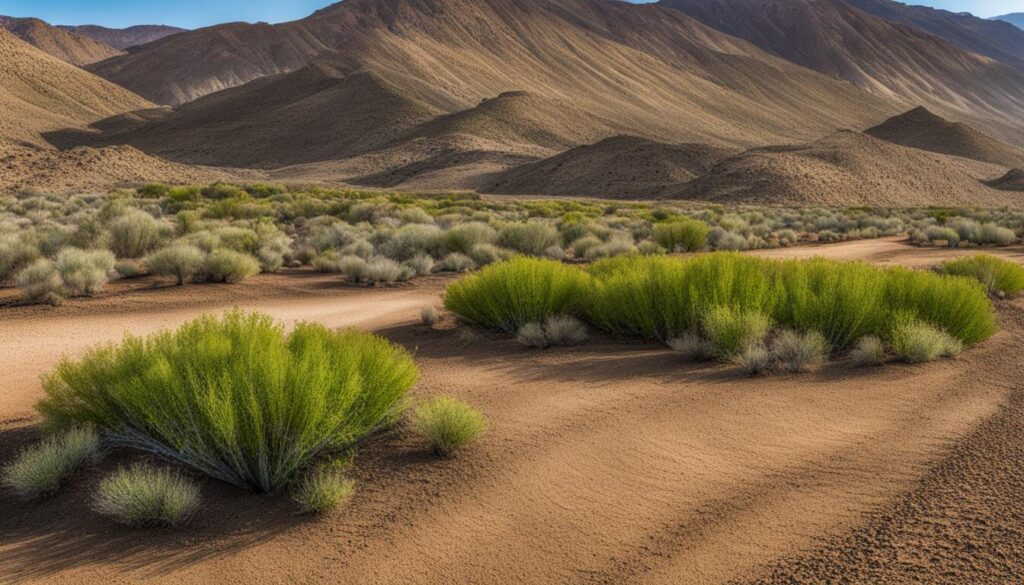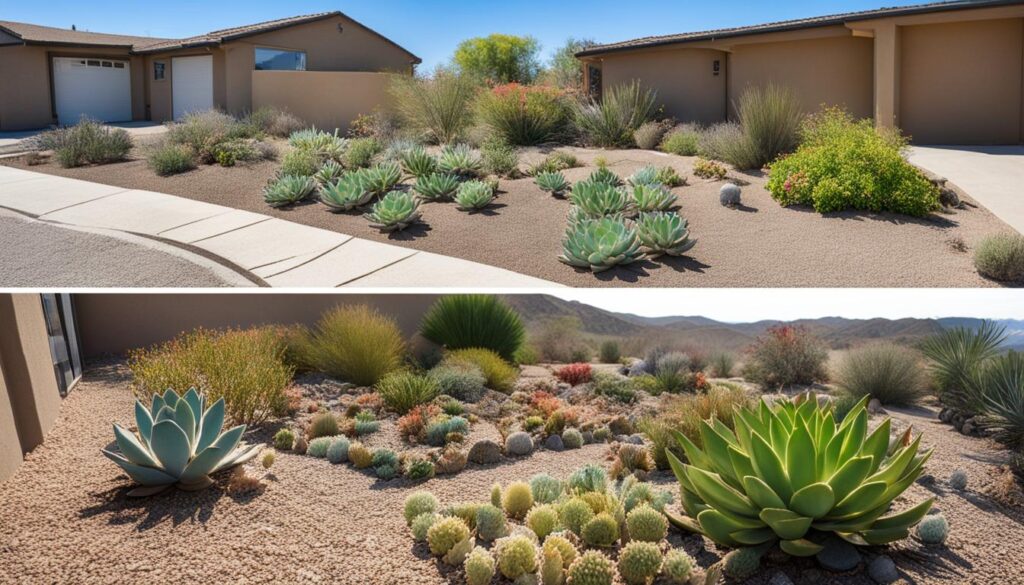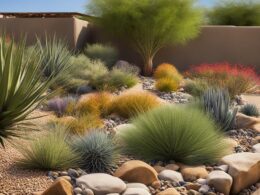Mulching is an important practice in urban green areas, including xeriscapes. Research has shown that the use of organic mulch can have significant benefits, such as water conservation, soil fertility improvement, and reduction of soil erosion and weed growth. The amount of mulch applied plays a crucial role in its effectiveness. Studies have found that an optimal mulch thickness of 0.25-0.50 kg/m2 is recommended for arid and semiarid regions experiencing heavy rainfall. This range of mulch application has been shown to maximize soil water content and decrease runoff compared to bare soil.
Key Takeaways:
- An optimal mulch thickness of 0.25-0.50 kg/m2 is recommended for xeriscapes in arid and semiarid regions.
- Organic mulch provides benefits such as water conservation, soil fertility improvement, and weed suppression.
- Mulch thickness affects soil water content and runoff, maximizing efficiency in xeriscape systems.
- Proper mulching techniques, such as even application and avoiding excessive mulch near tree trunks, are essential for optimal results.
- Avoid common mistakes such as excessive mulch and using inappropriate mulch materials for xeriscapes.
Benefits of Mulching in Xeriscapes
Mulching in xeriscapes can provide several benefits. One of the key advantages is water conservation. A layer of mulch helps to reduce water evaporation from the soil surface, allowing plants to utilize water more efficiently. Mulch also acts as an insulator, regulating soil temperature and protecting plant roots from extreme heat or cold. In addition, mulching controls weed growth, preventing competition for water and nutrients. It also improves soil structure and fertility as the mulch decomposes, providing organic matter that supports beneficial soil organisms and nutrient availability for plants. Overall, the use of mulch in xeriscapes helps to optimize water usage, reduce maintenance, and promote plant health.
By using mulch in your xeriscape garden, you can create a more sustainable and efficient landscape. Here are some key benefits of mulching:
- Water conservation: Mulch reduces water evaporation, allowing plants to make better use of the available water.
- Temperature regulation: Mulch acts as an insulator, protecting plant roots from extreme temperatures.
- Weed control: Mulch suppresses weed growth, reducing competition for water and nutrients.
- Soil improvement: As the mulch decomposes, it adds organic matter to the soil, enhancing its structure and fertility.
Incorporating mulch into your xeriscape not only saves water but also promotes healthier plants and reduces the need for regular maintenance. It is an effective and sustainable practice that can benefit both the environment and your garden.
Factors Affecting Mulch Application in Xeriscapes
When it comes to mulching in xeriscapes, several factors should be taken into consideration to ensure optimal results. These factors include soil slope, rainfall characteristics, type of mulch used, and local climate.
Soil slope plays a significant role in the functioning of mulch. Different slopes can affect soil water content and runoff, making it important to adapt the mulch thickness accordingly. Additionally, rainfall characteristics play a role in determining the ideal mulch thickness. Regions experiencing heavy rainfall may require a thicker mulch layer to prevent excessive runoff and erosion.
The type and composition of the mulch used also affect its effectiveness. Different materials, such as wood chips, bark, leaves, and compost, have varying rates of decomposition and water-holding capacity. It’s important to choose the right type of mulch based on its water retention capabilities and availability in the local area.
The local climate and availability of mulch materials are crucial factors in determining the ideal mulch thickness for xeriscapes. Considering the climate helps ensure that the chosen mulch can withstand the local weather conditions and provide the desired benefits. Availability of mulch materials locally not only affects the feasibility of using specific types of mulch but also impacts the costs and sustainability of mulching practices.
Factors Affecting Mulch Application in Xeriscapes:
| Factors | Considerations |
|---|---|
| Soil Slope | Adapt mulch thickness based on slope to manage water content and runoff. |
| Rainfall Characteristics | Heavy rainfall regions may require thicker mulch layers to prevent runoff and erosion. |
| Mulch Type | Choose materials with appropriate decomposition rates and water-holding capacity. |
| Local Climate | Select mulch that can withstand local weather conditions for long-term effectiveness. |
| Availability of Mulch Materials | Consider accessibility and sustainability of mulch materials in the local area. |
Proper Mulching Techniques for Xeriscapes
Proper mulching techniques are essential for maximizing the efficiency of mulch in xeriscapes. By following these techniques, you can ensure that your mulch provides optimal water conservation, weed suppression, and soil improvement. Here are some key practices to keep in mind:
- Apply mulch at the recommended thickness: It is important to apply mulch at the recommended thickness of 0.25-0.50 kg/m2. This range has been found to provide the best balance between soil water content and runoff reduction. Applying too little mulch may not provide adequate moisture retention, while applying too much can lead to excessive water retention and potential tree damage.
- Spread mulch evenly: When applying mulch, make sure to spread it evenly around plants, covering the entire area of soil containing the roots. This helps to prevent weed growth, insulate the soil, and regulate soil temperature. Avoid piling mulch up against the trunk of trees or plants, as this can trap moisture and cause rot or disease. Instead, leave the root flare exposed to allow for proper air circulation.
- Replenish mulch regularly: Over time, mulch will break down and decompose. To maintain the desired thickness and effectiveness of the mulch, it is important to replenish it regularly. This can be done by adding a fresh layer of mulch on top of the existing one. Regular replenishment will ensure that your mulch continues to provide the desired benefits to your xeriscape garden.
By following these proper mulching techniques, you can optimize the benefits of mulch in your xeriscape. Remember to select organic mulch materials, apply mulch evenly, and maintain the recommended thickness for the best results in water conservation, weed suppression, and soil improvement. Your xeriscape will thrive with the right mulching practices.
Table: Comparison of Mulch Application Techniques
| Technique | Advantages | Disadvantages |
|---|---|---|
| Proper Thickness |
|
|
| Even Distribution |
|
|
| Regular Replenishment |
|
|
Common Mistakes in Mulching Xeriscapes
Mulching is a beneficial practice in xeriscapes, but there are some common mistakes that should be avoided to ensure optimal results. By being aware of these mistakes and taking the necessary precautions, you can maximize the effectiveness of mulching in your xeriscape garden.
One of the most common mistakes is using excessive mulch, also known as “volcano mulching.” This occurs when mulch is piled up directly against the tree trunk, which can have detrimental effects on tree health. It can lead to oxygen starvation, root suffocation, and the development of diseases, insect infestations, and rodent damage. To avoid this, be sure to maintain the recommended mulch thickness and keep it away from the trunk.
Another mistake to avoid is using inappropriate mulch materials. Organic mulches, such as wood chips or bark, are preferred for xeriscapes as they decompose over time and improve soil fertility. Inorganic mulches, like gravel or rubber, do not provide the same benefits. Choose the right type of mulch for your xeriscape garden to ensure maximum effectiveness.
Common Mistakes in Mulching Xeriscapes:
- Excessive mulch piled against the tree trunk, causing harm to tree health.
- Using inappropriate mulch materials that do not decompose or improve soil fertility.
- Failure to maintain the recommended mulch thickness for xeriscapes.
“Using excessive mulch can suffocate tree roots and cause a host of problems. Proper mulching techniques and careful selection of mulch materials can prevent these issues and ensure the benefits of mulching in xeriscapes.”
By avoiding these common mistakes, you can effectively utilize mulch in your xeriscape garden and reap its many benefits. Remember to follow proper mulching techniques, maintain the recommended mulch thickness, and choose the right materials for your xeriscape. With these precautions in place, you can enhance the sustainability of your landscape and promote the health and beauty of your plants.
How Does Mulch Thickness Affect Xeriscape Efficiency?
When considering the efficiency of xeriscaping, the thickness of mulch plays a crucial role. Adequate mulch thickness, as recommended by tips for xeriscape mulch longevity, helps conserve moisture, suppress weeds, and regulate soil temperature. Thicker mulch layers enhance these benefits and contribute to the overall success of xeriscaping.
Conclusion
In conclusion, the optimal mulch thickness for xeriscape efficiency is crucial in maximizing its benefits. Research suggests that applying a mulch thickness within the range of 0.25-0.50 kg/m2 provides the best results in terms of water conservation, soil improvement, and weed control. By following proper mulching techniques, you can enhance the sustainability of your xeriscape garden.
To achieve the best results, ensure that you select organic mulch materials such as wood chips or bark, as they decompose and improve soil fertility over time. Applying mulch evenly around plants, covering the area of soil that contains the roots while avoiding piling it up against the trunk, is essential to prevent moisture buildup and potential tree damage. Regularly replenishing the mulch will help maintain the desired thickness and ensure its continued effectiveness.
Avoid common mistakes such as excessive mulching, known as “volcano mulching,” which can lead to various issues like oxygen starvation, root suffocation, and pest infestations. Additionally, using inappropriate mulch materials like gravel or rubber can hinder the benefits of mulching in xeriscapes. By following these guidelines, you can optimize the benefits of mulch and promote the overall health of your xeriscape garden.












